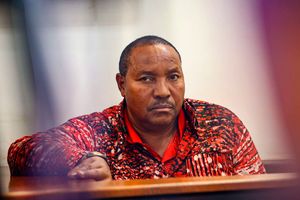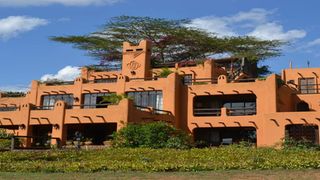
The African Heritage House in Mlolongo in a picture taken on February 13, 2014.
| File | Nation Media GroupLifestyle
Premium
The making of an architectural marvel that is African Heritage House
What you need to know:
- The floors, walls, windows and ceilings are a replica of Swahili architecture and its usage of locally available materials such as mazeras stone slabs for the floors, while the mangrove poles on the ceiling make it as African as it can be.
- The architectural outcome falls into Donovan’s initial plan to construct a house that was African in every way possible.
Donovan did not have a dream house until he saw the pre-colonial African mud hut.
He worked as a program officer for USAID, stationed in Nigeria and later as a relief officer during the Nigeria-Biafra War. Having lived through rising tension between races in the US, he joined the Civil Rights Movement, an experience that opened his eyes to the terrible impact of racism.
His job as a relief officer was becoming increasingly dangerous as relief food planes were shot down and trucks hijacked. Meanwhile, he was learning more about African craftwork, which he was fascinated with.
By 1968, he was rethinking his career path. While on a ship enroute to Paris to study French for his next assignment in Tunisia, he wrote his resignation letter, quitting his job. But he still went to France to study French as he intended to tour Africa before returning home.
While in France, he bought a bus which he used to travel from Paris to Morocco, crossing the Sahara Desert to Nigeria and continuing on across the continent, arriving in Kenya in 1970, where he spent several months in the Northern Frontier of the country. While there, a passion for collecting and preserving African crafts was ignited.
Fifty-four years later, on a sunny Monday afternoon, Donovan sits at the corridor of his home, the African Heritage House along Mombasa Road. His home is now a national monument, a house museum that local and international tourists visit to experience and witness the African heritage preserved in the house.
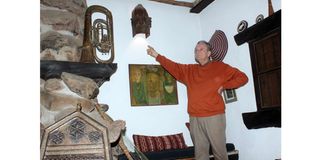
Founder of African Heritage House Alan Donovan displays artifacts in the house on August 1, 2015.
Close by, an old cargo train rumbles by on a railway line which the property overlooks. It snakes along the old curved railway, at a moderate tempo. Later, a newer commuter train appears. It’s bright orange and yellow stripes are hard to ignore. Quite a contrast from the previous train, the perfect symbol of the changing face of Africa. The second train vanishes much faster, leaving a nostalgic feeling. Perhaps, another symbol of the speed with which African heritage is vanishing.
Architectural Masterpiece
The African Heritage House was declared a national monument in January, 2016 by the National Museums of Kenya. Donovan says the declaration was a pleasant surprise at a low point in his life. The construction of the new Standard Gauge Railway Line was ongoing and the house faced possible demolition to make way for the railway’s new proposed route. Being declared a national monument was therefore a major saving grace for both the house and the crafts it houses.
The house stands tall at three stories, defying modesty. Its brown, earthen colour almost assimilates to the soil’s appearance, yet standing out due to its unique design that resembles a neatly installed crown. The front part of the house, as Donovan explains, was inspired by an ancient mud mosque in Mali while the side elevation was inspired by an Emir’s palace in Nigeria.
The floors, walls, windows and ceilings are a replica of Swahili architecture and its usage of locally available materials such as mazeras stone slabs for the floors, while the mangrove poles on the ceiling make it as African as it can be.
The architectural outcome falls into Donovan’s initial plan to construct a house that was African in every way possible.
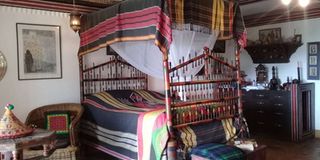
Lamu Room African Heritage House.
While a unique architectural concept is a key attribute in monuments and museums, it takes more to earn respect and recognition, especially on a global scale. Rich history and a good story always appeal to the masses.
The African Heritage House is a collection of memories, friendships, partnerships and artefacts, some as old as a century, like the Lamu-sourced beds in the bedrooms.
A tour of the house is like a journey through time and space. Mentally, you cross borders from one country to another exploring hundreds of handcrafts, textiles, African-themed furniture, décor accessories, images and artwork that bears many untold African stories.
From Benin, there are numerous tales imprinted on metal plates. Tales about ancient kings and folklore. In Nigeria, the Yoruba tribe is represented with traditional head gears, textiles and interesting wooden plates used by traditional fortune tellers to foretell the future.
From Uganda, the sculptor John Odoch Ameny dominates the outdoors with thematic iron sculptures.
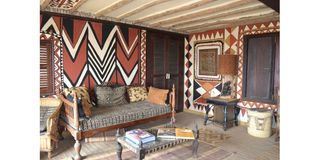
Maasai Lounge at the African Heritage House .
With each piece there is a story and with each story there is heritage. For instance, on one of the corridors, you’ll find a wall displaying Akamba beadwork. For a community famed, even ridiculed for their ‘excessive’ adoration of colour, Donovan’s collection dictates otherwise.
White, which is considered the colour of fertility in the community, dominates the collection as white beads serve as a background for every piece. They were used by the Arab traders on their way to the King of Buganda who sought white beads to pay their Wakamba guides through Maasai land.
Among his Turkana collection, Donovan makes a special mention of the Akarum, a carved wooden milk container with very thin curved walls based on a gourd prototype but carved from the wood of Acacia trees with a graceful top, like a modern-day thermos of exquisite design.
What is astounding is that every Turkana woman carves her own Akarum, using a broken spear, a hint of unmatched resilience among the community’s women.
The History
It is this resilience and the ability to carve beautiful handcrafts out of everything and anything, in a harsh environment that compelled Donovan to sell his only asset, the bus, to buy a collection of handcrafts from the Turkana people. He then had the first exhibition of this collection in 1970 at the Old Studio Arts 68 on Standard Street.
As fate would have it, the then Vice President, Joseph Murumbi, a renowned art collector, attended the exhibition. Later on, he requested Donovan to return to the Northern Frontier of Kenya to make another collection and he (Donovan) agreed. This was the beginning of a friendship that later led to the formation of the African Heritage Gallery in 1972.
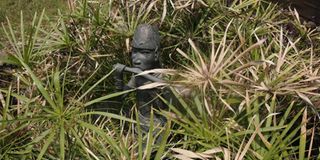
A statue is erected outside African Heritage House in Mlolongo, Machakos County.
Murumbi expressed interest in setting up a Pan-African Gallery, a place where artists from different countries would meet. But what’s interesting is how this gallery metamorphosised into different platforms that recognised, appreciated and promoted African heritage. After setting up the first gallery, Donovan had the privilege of travelling to 20 countries buying handcrafts from African artists.
“At the time we didn’t have credit cards or mobile money, so, I would travel with cash. Packaging was also a challenge, at times I was forced to use unbelievable forms of packing, such as wooden coffins to carry the handcrafts because they were the only containers that would safely transport some of the fragile awkwardly shaped crafts such as huge old Fulani incised gourd milk bowls,” he recalls
In 1976, after numerous trips and endless collecting, a fire burnt down the first African Heritage gallery on Kenyatta Avenue where the I&M Tower is today.
They managed to save several items, a few of which are currently housed at the African Heritage House. As tragic as the fire was, they still searched through the ashes, retrieved and repaired some crafts and held a “fire sale” which enabled them to buy more stock.
Global Recognition
By the time Donovan constructed the African Heritage House at Mombasa Road (between 1989 and 1994), his mission had evolved from exploring Africa to jewellery making and exporting, fashion events, exhibitions, TV and radio shows and even teaching. With a staff of over 500, mostly craftspeople, he established 51 outlets across the world showcasing African heritage, which he closed down in 2003.
The house has appeared on the covers of major décor magazines from around the world. Donovan has also been crowned as a ceremonial Yoruba chief with the title Babalaje of Ido Osun (2019), recognising his dedication toward preserving African heritage.
The house has also earned the title “Most Photographed House in Africa” and it attracts tourists, local and international, who visit to witness the Africa that was.

A grand seat displayed at African Heritage House in Mlolongo, Machakos County.
His next project is establishing a Pan-African studies centre that will pass on information about the rich African heritage to younger generations. He notes, with concern, that African heritage is barely appreciated by Africans and is rapidly vanishing.
He recalls a time when richly patterned African textiles were easily available. At the time, he ventured into fashion and even designed clothes for his fashion events. But now, he says you would be lucky to even spot certain fabrics such as the Kuba textiles of the Congo.
“I’m happy to have lived through an era where African textiles were beautifully authentic,” he comments.
By establishing a Pan-African studies centre, he hopes that younger generations will learn to appreciate their roots and keep their heritage alive. As the world waited out the Covid-19 pandemic, he was busy writing books, including one titled Black Beauty, to be published by Rizzoli in New York.
The Fate of the House
While establishing an iconic space has been a long and exciting journey, challenges have abounded. Over the years, obstacles have come and gone, but at the moment, his primary worry is the fate of the house.
He is in the process of looking for a buyer who will operate the house as a national monument and Pan African studies centre in conjunction with Strathmore and other universities and continue offering homestays, meals, space for events, and tours of the house.
“The biggest challenge is to find someone who will love, cherish and share the house as I have. It is not a matter of money, it is a matter of the quality, attitude and history of the buyer,” says Donovan.





